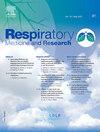The predicted value of maximal inspiratory pressure, maximal expiratory pressure, and sniff nasal inspiratory pressure for southeast asian adults
IF 1.8
4区 医学
Q3 RESPIRATORY SYSTEM
引用次数: 0
Abstract
Background
Accurate assessment of respiratory muscle strength is crucial for diagnosing and managing respiratory diseases. However, existing reference values may not be generalizable across diverse populations. This study aimed to establish predicted values for maximal inspiratory pressure (MIP), maximal expiratory pressure (MEP), and sniff nasal inspiratory pressure (SNIP) in Southeast Asian adults.
Methods
MIP, MEP, and SNIP were measured in 301 healthy Vietnamese adults. Two-way ANOVA and post-hoc tests were used to examine differences in these measures among age groups and between genders. Stepwise multiple linear regression was used to develop predictive equations for MIP, MEP, and SNIP, with potential predictors including age, gender, body mass index, and lung function. The lower limit of the normal range (LLN) was determined using the fifth percentile of the negative residuals.
Results
MIP, MEP, and SNIP were higher in males than in females. MIP and MEP declined with age, while SNIP remained relatively stable. Predictive equations were established: MIP = 95.2 – 32.1 x gender (male = 0, female = 1) – 0.41 x age + 1.2 x BMI (adjusted R2: 41 %, LLN = predicted MIP – 34), MEP = 135.1 – 46.75 x gender (male = 0, female = 1) - 0.6 x age + 1.34 x BMI (adjusted R2: 41.8 %, LLN = predicted MEP – 50), SNIP = 63.8 – 18.16 x gender (male = 0, female = 1) (adjusted R2: 14.8 %, LLN = predicted SNIP – 30).
Conclusions
This study provides ethnic-specific predictive equations for MIP, MEP, and SNIP, which may serve as a preliminary step toward developing reference values for the Southeast Asian region.
东南亚成人最大吸气压力、最大呼气压力和嗅鼻吸气压力的预测值
背景:准确评估呼吸肌力量对诊断和治疗呼吸系统疾病至关重要。然而,现有的参考值可能无法在不同的人群中推广。本研究旨在建立东南亚成年人最大吸气压力(MIP)、最大呼气压力(MEP)和嗅鼻吸气压力(SNIP)的预测值。方法测定301例越南健康成人的smip、MEP和SNIP。采用双向方差分析和事后检验来检验这些措施在年龄组和性别之间的差异。采用逐步多元线性回归建立MIP、MEP和SNIP的预测方程,潜在的预测因子包括年龄、性别、体重指数和肺功能。正常范围的下限(LLN)是用负残差的第5个百分位数确定的。结果男性smip、MEP、SNIP均高于女性。MIP和MEP随年龄增长而下降,而SNIP保持相对稳定。建立了预测方程:MIP = 95.2 - 32.1 x性别(男= 0,女= 1)- 0.41 x + 1.2岁BMI (R2调整:41%,LLN =预测MIP - 34),欧洲议会议员= 135.1 - 46.75 x性别(男= 0,女= 1)- 0.6 x + 1.34岁BMI (R2调整:41.8%,LLN =预测MEP - 50),剪断= 63.8 - 18.16 x性别(男= 0,女= 1)(R2调整:14.8%,LLN =预测剪断- 30)。结论本研究提供了种族特异性的MIP、MEP和SNIP预测方程,为东南亚地区开发参考值奠定了基础。
本文章由计算机程序翻译,如有差异,请以英文原文为准。
求助全文
约1分钟内获得全文
求助全文
来源期刊

Respiratory Medicine and Research
RESPIRATORY SYSTEM-
CiteScore
2.70
自引率
0.00%
发文量
82
审稿时长
50 days
 求助内容:
求助内容: 应助结果提醒方式:
应助结果提醒方式:


